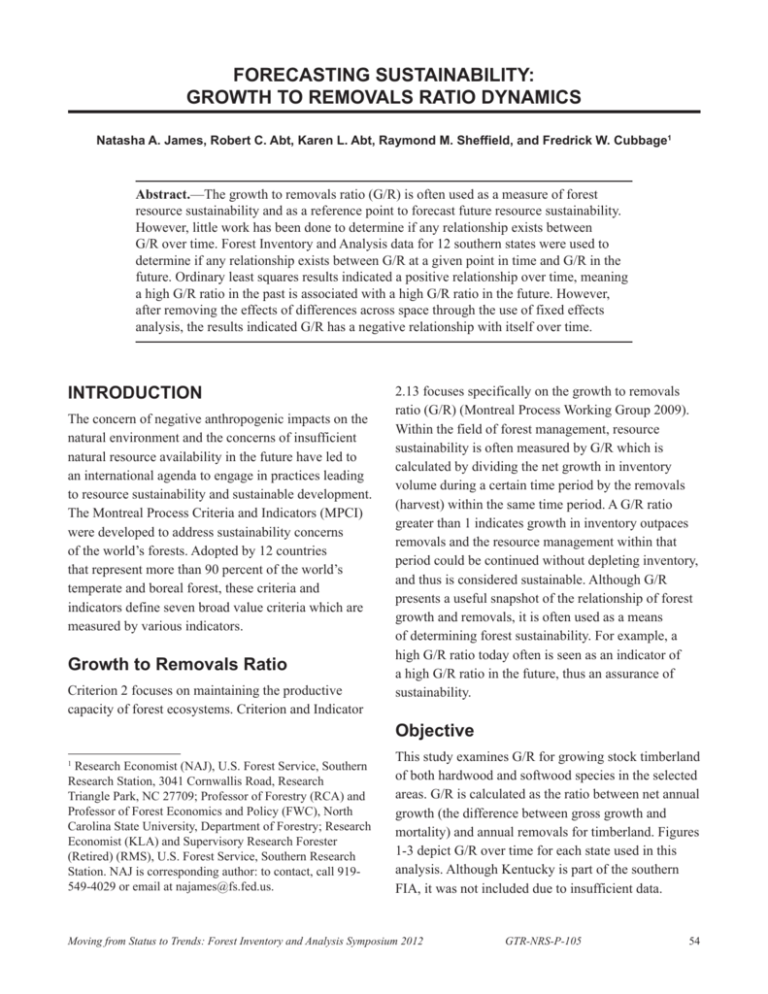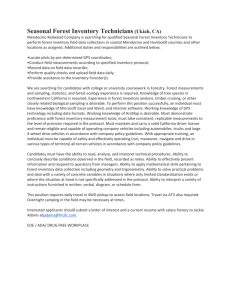Forecasting Sustainability: Growth to Removals Ratio
advertisement

FORECASTING SUSTAINABILITY: GROWTH TO REMOVALS RATIO DYNAMICS Natasha A. James, Robert C. Abt, Karen L. Abt, Raymond M. Sheffield, and Fredrick W. Cubbage1 Abstract.—The growth to removals ratio (G/R) is often used as a measure of forest resource sustainability and as a reference point to forecast future resource sustainability. However, little work has been done to determine if any relationship exists between G/R over time. Forest Inventory and Analysis data for 12 southern states were used to determine if any relationship exists between G/R at a given point in time and G/R in the future. Ordinary least squares results indicated a positive relationship over time, meaning a high G/R ratio in the past is associated with a high G/R ratio in the future. However, after removing the effects of differences across space through the use of fixed effects analysis, the results indicated G/R has a negative relationship with itself over time. INTRODUCTION The concern of negative anthropogenic impacts on the natural environment and the concerns of insufficient natural resource availability in the future have led to an international agenda to engage in practices leading to resource sustainability and sustainable development. The Montreal Process Criteria and Indicators (MPCI) were developed to address sustainability concerns of the world’s forests. Adopted by 12 countries that represent more than 90 percent of the world’s temperate and boreal forest, these criteria and indicators define seven broad value criteria which are measured by various indicators. Growth to Removals Ratio Criterion 2 focuses on maintaining the productive capacity of forest ecosystems. Criterion and Indicator 2.13 focuses specifically on the growth to removals ratio (G/R) (Montreal Process Working Group 2009). Within the field of forest management, resource sustainability is often measured by G/R which is calculated by dividing the net growth in inventory volume during a certain time period by the removals (harvest) within the same time period. A G/R ratio greater than 1 indicates growth in inventory outpaces removals and the resource management within that period could be continued without depleting inventory, and thus is considered sustainable. Although G/R presents a useful snapshot of the relationship of forest growth and removals, it is often used as a means of determining forest sustainability. For example, a high G/R ratio today often is seen as an indicator of a high G/R ratio in the future, thus an assurance of sustainability. Objective Research Economist (NAJ), U.S. Forest Service, Southern Research Station, 3041 Cornwallis Road, Research Triangle Park, NC 27709; Professor of Forestry (RCA) and Professor of Forest Economics and Policy (FWC), North Carolina State University, Department of Forestry; Research Economist (KLA) and Supervisory Research Forester (Retired) (RMS), U.S. Forest Service, Southern Research Station. NAJ is corresponding author: to contact, call 919549-4029 or email at najames@fs.fed.us. 1 This study examines G/R for growing stock timberland of both hardwood and softwood species in the selected areas. G/R is calculated as the ratio between net annual growth (the difference between gross growth and mortality) and annual removals for timberland. Figures 1-3 depict G/R over time for each state used in this analysis. Although Kentucky is part of the southern FIA, it was not included due to insufficient data. Moving from Status to Trends: Forest Inventory and Analysis Symposium 2012 GTR-NRS-P-105 54 Even though it is common practice to use a G/R ratio greater than 1 as an indicator of continued sustainability in the future, Figures 1-3 show a relationship over time where periods of low G/R are followed by periods of high G/R, suggesting a cyclical, negative relationship (Sheffield 2012). The objective of this study was to investigate how well G/R in the past explains G/R today. Gulf States 2.5 G/R ratio 2 1.5 1 0.5 0 0 1 2 3 4 5 6 Period Alabama Louisiana Mississippi Texas Figure 1.—G/R ratio over time for southern states bordering the Gulf of Mexico. Coastal States 2.5 G/R ratio 2 1.5 1 0.5 0 0 1 2 Period Florida North Carolina Virginia 3 4 5 6 Georgia South Carolina Figure 2.—G/R ratio over time for southern states bordering the Atlantic coast. Moving from Status to Trends: Forest Inventory and Analysis Symposium 2012 GTR-NRS-P-105 55 Interior States 3 G/R ratio 2.5 2 1.5 1 0.5 0 0 1 2 3 4 5 6 Period Arkansas Oklahoma Tennessee Figure 3.—G/R ratio over time for interior southern states. DATA The data used in this analysis were extracted from the Forest Inventory and Analysis (FIA) database. Data relating to annual removals and net growth were collected at the survey unit level for the 12 southern states. Although net growth and annual removals are estimates containing their own standard errors, for the purposes of this paper they are both being treated as population values. Historically, the FIA Program collected data using a 10-year periodic survey. In 1998, the Agricultural Research, Extension, and Education Reform Act (PL 105-185) required an annual inventory. However, the panel design described by Bechtold and Patterson (2005) was implemented. This panel design allows federal funding for a 10 panel design in the East. Many southern states use a 5 panel design in which 20 percent of plots within a state are sampled each year, creating full inventory reports in 5-year cycles (Smith and Oswalt 2010). Due to the inconsistency in survey dates, the years in which surveys took place were divided into the following periods: Period 1: 1970-1978 Period 2: 1979-19872 Period 3: 1988-1993 Period 4: 1994-2003 Period 5: 2004-2008 Period 6: 2009-2010 METHODS Ordinary least squares (OLS) analysis was used to determine if any relationship exists between G/R today and in the past. In this analysis, each period for each state is a single observation. In addition, fixed effects analysis was applied which controls for the average differences across space (states) in order to observe only the effects of time on G/R. In this analysis, the cross section was defined as the state and the time Florida had 2 surveys during Period 2 (1980 and 1987). The 1987 survey data are included in Period 3. 2 Moving from Status to Trends: Forest Inventory and Analysis Symposium 2012 GTR-NRS-P-105 56 series was defined in periods, as shown above. The models analyzed for both procedures were: Model 1: (G/R)T = f ( (G/R)T-1 ) Model 2: (G/R)T = f ( (G/R)T-2 ) Model 3: (G/R)T = f ( (G/R)T-1, (G/R)T-2 ), where (G/R)T is G/R of the current period; (G/R)T-1 is G/R lagged one period; and (G/R)T-2 is G/R lagged two periods. RESULTS AND DISCUSSION Three OLS models and three fixed effects models were used to examine the relationship G/R has with itself over time. The first model focuses on the relationship between G/R of the current period and the G/R lagged one period. The second model focuses on the relationship between G/R of the current period and the G/R lagged two periods. The final model focuses on the relationship between G/R of the current period and the G/R lagged one and two periods. Results from OLS and fixed effects analysis are listed in Table 1 and Table 2, respectively. In each model the parameter coefficients are positive and significant at the 1 percent level. This result suggests G/R has a positive relationship with itself over time. However, the R2 values are relatively low, ranging from 0.14-0.24. Table 1.—Results from Ordinary Least Squares (OLS) analysis of G/R on lagged values of G/R for 12 southern states (standard errors in parentheses) Constant (G/R)T-1 Model 1 Model 2 0.83 0.96 0.45*** (0.08) (G/R)T-2 0.32*** (0.09) Model 3 0.74 0.30*** (0.10) 0.16*** (0.10) Number of observations 102 78 78 Adjusted R2 0.24 0.14 0.23 Note: ***indicates significance at 1%. Through the use of fixed effects analysis, the average differences across states are isolated to determine whether G/R at a point in time has implications for determining G/R in the future. In each model, the F statistic (Fstat) is significant at the 5 percent level, indicating there are group effects across space and that OLS would not be expected to produce reasonable results. Although the R2 values are higher (0.550.72), the relationship between G/R today and its values lagged one period and two periods (Model 1 and 2) lack significance even at the 20 percent level. However, when analyzed simultaneously (Model 3), (G/R)T-1 and (G/R)T-2 show a significant, negative relationship with G/R of the current period. This result implies an inverse relationship where the higher G/R is in the past, the lower it will be in the future. CONCLUSION AND FUTURE WORK The results from this study show that when controlling for the average differences across space, empirical evidence suggests that G/R has a negative relationship with itself over time. This analysis is just one of many steps in understanding G/R. In the South, the G/R is rarely below 1. Future work should include regions where G/R is not as stable. Future analysis should include examination of hardwoods and softwoods separately, as these ratios can be different over time. Table 2.—Results from fixed effects analysis G/R on lagged values of G/R for 12 southern states (standard errors in parentheses) Model 1 Model 2 Constant 1.91 (G/R)T-1 (G/R)T-2 Number of cross sections Time series length Adjusted R 2 a 2.02 -0.10a (0.14) Model 3 2.63 -0.33*** (0.14) -0.18 (0.15) 0.21* (0.14) 12 12 12 5 4 4 0.55 0.66 0.72 ***indicates significance at 1%, *indicates significance at 20%. Moving from Status to Trends: Forest Inventory and Analysis Symposium 2012 GTR-NRS-P-105 57 In addition, stronger statistical analyses such as spectral analysis or Fourier regression could be applied to determine cyclical relationships. ACKNOWLEGDMENTS The authors would like to thank Evan Mercer and John Coulston for their review of this paper. Their feedback contributed greatly to the content. LITERATURE CITED Bechtold, W.; Patterson, P., eds. 2005. The enhanced forest inventory and analysis program— National sampling design and estimation procedures. Gen. Tech. Rep. GTR-SRS-80. Asheville, NC: U.S. Department of Agriculture, Forest Service, Southern Research Station. 85 p. Montreal Process Working Group. 2009. Criteria and indicators for the conservation and sustainable management of temperate and boreal forests. Available at www.mpci.org. (Accessed December 2011). Sheffield, R. 2012. Growth-Removal Ratio-An indicator of stability? In: Proceedings, 2012 Southern Forest Resource Assessment Consortium annual conference; 2012 August 8-9; Durham, NC. Smith, B.; Oswalt, S.N. 2010. Status and progress in large scale assessments of the productive capacity of forest ecosystems in the United States. Journal of Forestry. 109(4): 226-232. The content of this paper reflects the views of the author(s), who are responsible for the facts and accuracy of the information presented herein. Moving from Status to Trends: Forest Inventory and Analysis Symposium 2012 GTR-NRS-P-105 58







